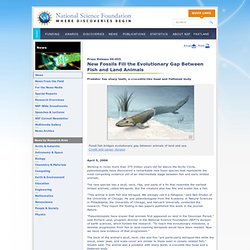

Lines of evidence: The science of evolution. New Fossils Fill the Evolutionary Gap Between Fish and Land Animals. Press Release 06-055 New Fossils Fill the Evolutionary Gap Between Fish and Land Animals Predator has sharp teeth, a crocodile-like head and flattened body April 5, 2006 Working in rocks more than 375 million years old far above the Arctic Circle, paleontologists have discovered a remarkable new fossil species that represents the most compelling evidence yet of an intermediate stage between fish and early limbed animals.

The new species has a skull, neck, ribs, and parts of a fin that resemble the earliest limbed animals, called tetrapods. But the creature also has fins and scales like a fish. "This animal is both fish and tetrapod. "Paleontologists have known that animals first appeared on land in the Devonian Period," said Richard Lane, program director in the National Science Foundation (NSF)'s division of earth sciences, which funded the research. Scientists collected the fossils during four summer explorations on Ellesmere Island in Canada's Nunavut Territory. Get News Updates by Email. What has the head of a crocodile and the gills of a fish? Unpredictable Evolution in a 30-Year Study of Darwin's Finches.
Evolution of Character Displacement in Darwin's Finches. The fossil record of ‘early’ tetrapods: evidence of a major evolutionary transition? By Paul Garner Summary According to evolutionary theory, the origin of tetrapods from a fish-like ancestor during the Devonian Period was one of the major events in the history of life on earth.

The ‘drying pond’ hypothesis was proposed to explain the selection pressures behind the transition. According to this hypothesis, the tetrapods evolved as fishes became progressively better adapted to terrestrial conditions during prolonged episodes of drought. Recently, however, the assumption that feet and legs evolved to facilitate life on the land has been called into question. Evolutionists believe that tetrapods—i.e. vertebrates with four limbs—were the first animals to move on to the land, having evolved from a fish ancestor during the Devonian period (conventionally 408 to 360 million years ago).
‘About 370 million years ago, something strange and significant happened on Earth. The ‘drying pond’ hypothesis Many evolutionary scenarios have been proposed to explain the origin of tetrapods. Human Ears Evolved from Ancient Fish Gills. Your ability to hear relies on a structure that got its start as a gill opening in fish, a new study reveals.

Humans and other land animals have special bones in their ears that are crucial to hearing. Ancient fish used similar structures to breathe underwater. Scientists had thought the evolutionary change occurred after animals had established themselves on land, but a new look at an old fossil suggests ear development was set into motion before any creatures crawled out of the water. The transition Researchers examined the ear bones of a close cousin of the first land animals, a 370-million-year-old fossil fish called Panderichthys. In the other fish, Eusthenopteron, a small bone called the hyomandibula developed a kink and obstructed the gill opening, called a spiracle.
However, in early land animals such as the tetrapod Acanthostega, this bone has receded, creating a larger cavity in what is now part of the middle ear in humans and other animals.